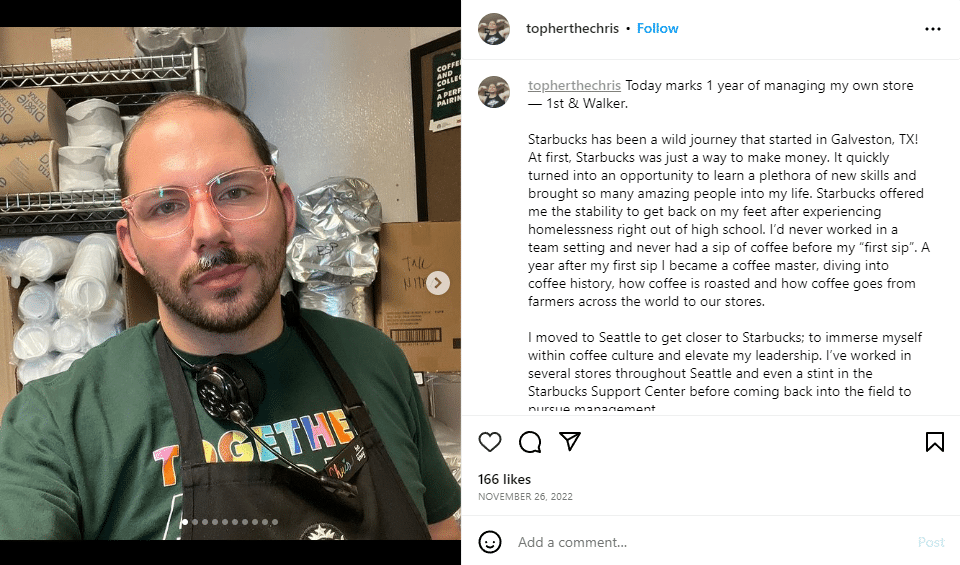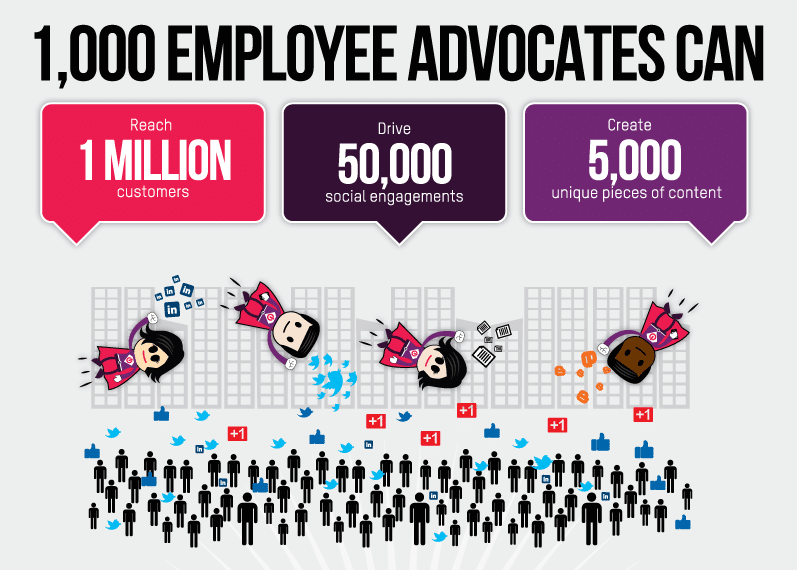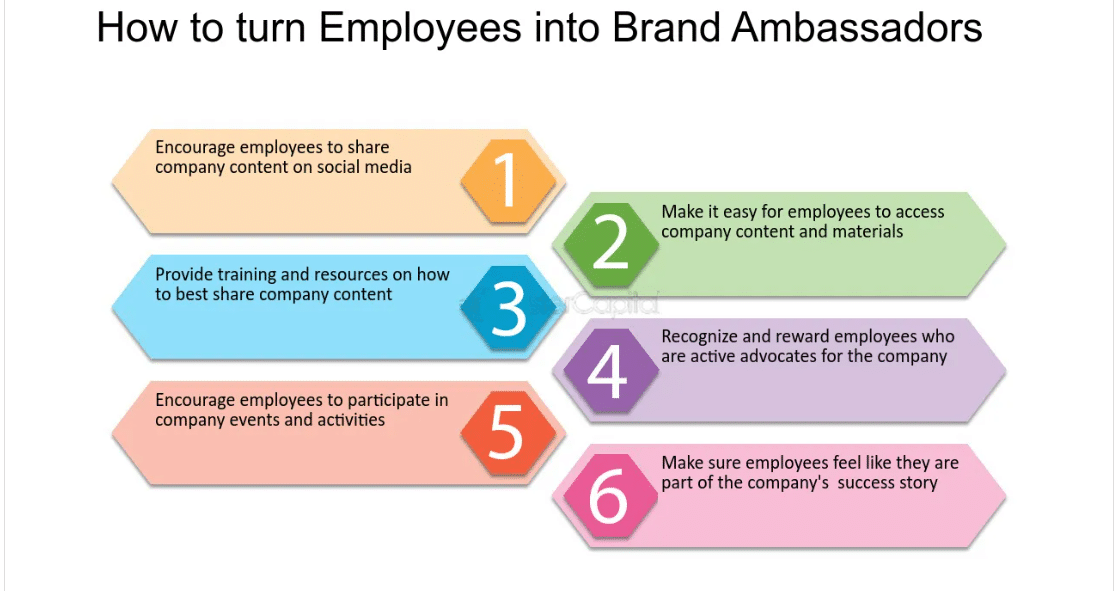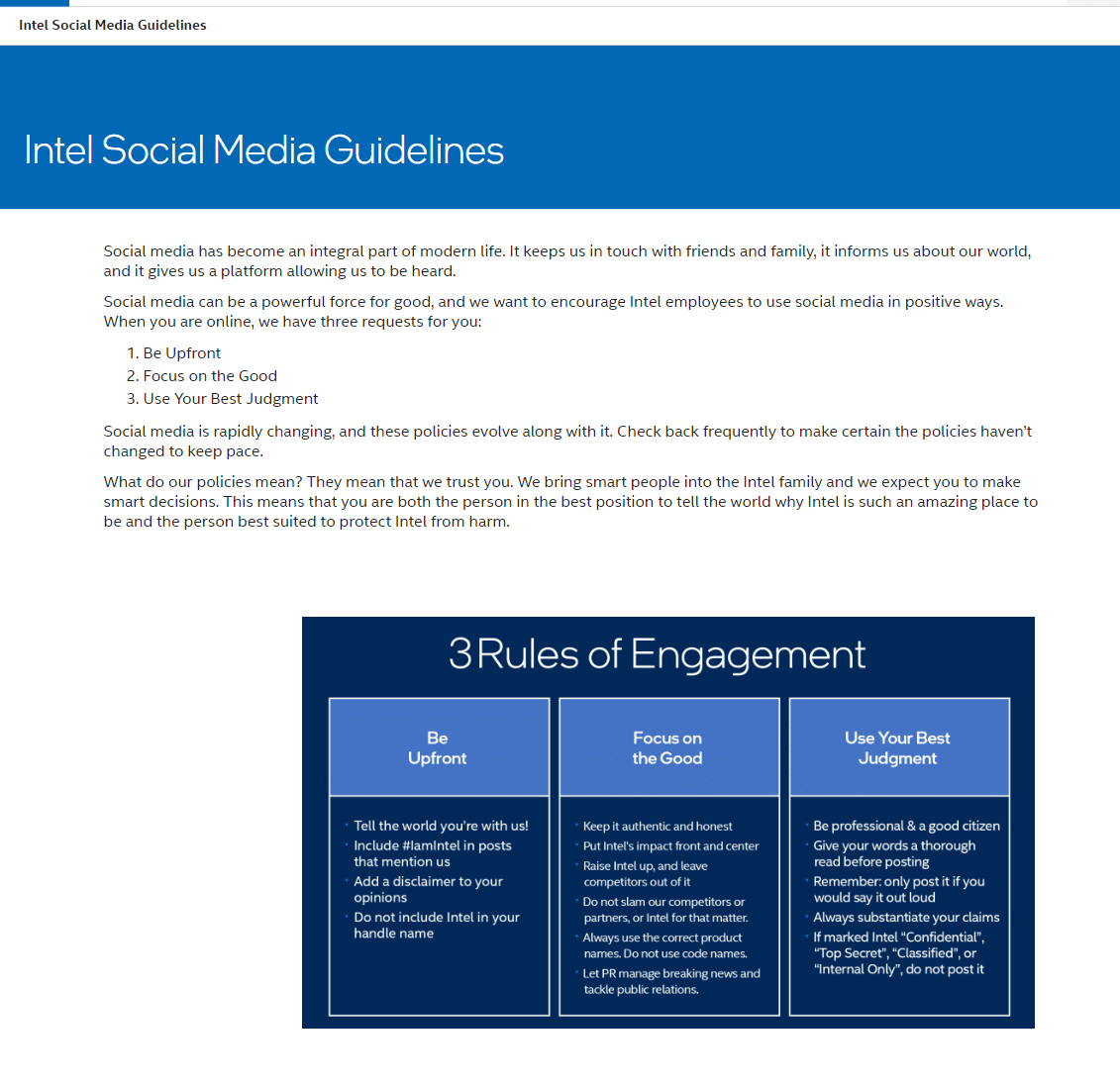Employee advocacy is one of the most overlooked methods that can help you grow your company’s reach, boost your public image, and increase employee engagement. In a world run by social media, you can take full advantage of your workforce by building a social media employee advocacy program.
In this guide, we’ll look at what social media employee advocacy is, its benefits, and best practices. You will learn how to build an effective strategy to engage your employees and contribute to your business results.
What is social media employee advocacy?
Employee advocacy refers to activities undertaken by employees to promote the organization they work in. Social media employee advocacy mostly involves employees sharing company content on their personal social media accounts.
People tend to trust what others say over official brand statements, so what your workforce says about your brand or company matters. You can harness the power of social media advocacy by having your employees promote the company and its values on their social media accounts, ideally with trackable links that lead to your website.
Social media employee advocacy can be organic or part of a structured program. A structured program makes it easier to mobilize employees, set goals, and measure them. This way, you can correctly attribute ROI to your employees’ marketing efforts.
Your company cannot afford to overlook the increasing importance of employee advocacy in today’s digital landscape. You only need to look at case studies of companies crushing employee advocacy to see how much of a game-changer it is.
Social media employee advocacy examples
Reebok, a popular sports apparel company, has had a successful employee advocacy program. The company encourages employees to post photos of themselves in company products on their personal social media accounts. The employees embraced the challenge, posting running, cycling, and weightlifting photos with their custom hashtag, #FitAssCompany.
Starbucks is another good example, with its “Starbucks Partners” employee advocacy program. All employees that promote their company, including on social media, earn the title “Partner.” The program has been a great success and an invaluable source of employee learning opportunities.
Benefits of social media employee advocacy
Harnessing the power of your workforce through social media employee advocacy will help increase your company’s reach without exceeding your marketing budget. A wider social media reach equals better opportunities to engage your audiences meaningfully and generate leads organically.
Here are some of the major benefits of employee advocacy:
Increasing brand visibility and reach
Social media employee advocacy is a powerful tool that can help organically extend your brand reach on social media platforms. Social networks tend to prioritize personal interactions over branded content, and your employees have individual networks you can capitalize on.
With the right content marketing strategy, your employees’ personal networks can be a powerful marketing strategy. According to Neal Schaffer, brand messages are re-shared 24x when distributed by employees than shared by brands. Consumers trust the average employee more than the brand CEO, which increases engagement and helps you amplify your brand’s visibility.
Boosting customer acquisition
People tend to trust their peers over brand messages, so they’re more likely to trust the information your employees share. You can use employee advocacy on social media channels to improve your brand trust and credibility.
Your employees’ word-of-mouth is trusted more than messages from your brand, and their recommendations are seen to be authentic. This is an important part of social selling, as people will be more likely to purchase from you after recommendations from their peers.
With social media employee advocacy, you can infuse an element of personality and personal experience into your social media marketing strategy.
Attracting top talent
Employee advocacy, when done right, is a powerful recruitment tool. When your employees share brand content and showcase the company culture, it makes the company more appealing and makes it easier to attract top candidates for any open positions.
With social media employee advocacy, your employees act as brand ambassadors, sharing their positive experiences and opportunities. Employee ambassadors have established networks with like-minded professionals, so as they share content, it opens up a new pool of qualified candidates who view your company as a great place to work at.
Retaining top talent
Employee advocacy is also very instrumental in increasing employee retention and job satisfaction. Employee turnover is one of the major challenges facing companies post-pandemic. When your employees are also brand advocates, it gives them a vested interest in your company’s success. The more they serve as advocates, the more engaged they are in their work.
Best practices for encouraging social media employee advocacy
If you’re looking to build an employee advocacy program from the ground up, it may seem overwhelming. But with the right strategies and tools, it’s easier than you think. Here are the best practices that can help you set up a successful employee advocacy program.
Create a workplace culture that encourages employee advocacy
If your employees are happy and satisfied at the workplace, they are more likely to become brand ambassadors. The first step to creating an employee advocacy platform is creating a workplace that encourages advocacy. Open communication and collaboration are great examples of a positive workplace culture that encourages and fosters advocacy.
Successful employee advocacy needs leadership buy-in. When the leaders at the top model advocacy behavior, it’s easier for the other employees to follow suit. So, how do you create a supportive work environment that inspires employees to promote the brand? Here are a few tips:
- Give employees autonomy in decision-making, as this makes them feel empowered and invested at work.
- Recognize and celebrate employee achievements, as this helps motivate them to improve their efforts.
- Create open lines of communication to avoid alienation and silos.
- Offer career development opportunities so your employees don’t feel stagnant.
Google is one of the companies with a strong workplace culture that encourages advocacy. All corporate leaders in the company are taken through Bill Campbell’s communication lessons, and this has gone a long way in creating a great workplace that encourages advocacy.
Set goals and KPIs for your social media employee advocacy
Your employees may already be sharing brand content, but without clear strategies, objectives, and goals, it’s difficult to take full advantage and track progress. You need to set and communicate the goals of employee advocacy and come up with measurable social media metrics that will help measure their achievement.
Establish SMART employee advocacy goals, like engagement, brand visibility, talent acquisition, and purchases driven in given timeframes. It’s important to review your employee advocacy program regularly to see how much progress you’ve made and whether you need to adjust your program based on your findings.
Find social media employee advocacy leaders
While all your employees may be involved in your employee advocacy program, some will naturally excel, and it’s important to spot them and nurture them further. What are some characteristics of effective advocacy leaders?
- They are enthusiastic about sharing content and engaging on social media
- They are social media savvy
- They have a significant social media presence
- They are highly engaged in the workplace
It’s also important to support your employees by providing resources for advocacy. Without proper support, the advocacy program will feel like added work, dampening their enthusiasm. You can provide support by positioning your employees as industry experts and providing them with the content needed to make the job easier.
Establish guidelines for employee social promotion
Aside from the actual content to be shared, it’s also paramount to establish clear guidelines to help your employees as they share content. They should not only know what to say but how to say it as well. The guidelines should cover topics like content, tone, and disclosure of affiliation.
Your company should provide educational resources and regular training sessions to ensure the employees understand the guidelines to avoid security risks. You can create a brand style guide to help set the tone of your content. You can also have a content policy, including the do’s and don’ts of social media.
The guidelines should serve as a guide and not be used to police employee content. If the guidelines are too strict, it may deter your employees from sharing content to avoid risking their jobs.
Starbucks is a great example of a well-done employee social media policy. It’s a set of clear and concise guidelines that’s publically available and easily accessible.
Incentivize employees to be employee advocates
You can get your employees more involved and active in your employee advocacy platform by using incentives such as prizes, gift cards, or event tickets. It’s even more beneficial to gamify the process, where you have a contest of sorts and reward the best employee advocate.
Some of the incentives should be tied to specific KPIs like purchases or engagement. Recognizing and rewarding employee efforts motivates them to keep participating and keeps them engaged in the workplace.
Empower employees as brand ambassadors
You may have a content marketing strategy and support your employees by providing resources, but ultimately, the content should come from the employees themselves. It needs to be as genuine and authentic as possible, as this will lead to higher engagement. When the content is personalized, it’s more fun for the employees, and their audience can easily recognize their voice.
You can support your brand ambassadors by providing the resources they may need to answer questions from customers, potential candidates, and leads. The leader’s role, in this case, is to create an enabling system that fosters advocacy.
Choose the right employee advocacy platform
Even with all the resources at your disposal, consolidating all this information and executing your employee advocacy program may be a challenge. One way to overcome this problem is to use an employee advocacy platform.
You have many software platforms to choose from, but essential features to look for include creation tools, employee engagement features, and detailed analytics dashboards. Mobile accessibility and ease of use are also determinants of an effective employee advocacy platform.
One of the greatest benefits of using employee advocacy software is it creates trackable links. Normally, it’s difficult to track social media advocacy, but with unique links, it’s possible to tie purchases back to a specific employee’s advocacy efforts.
Some of the most popular employee advocacy software include Referral Rock, Hootsuite Amplify, Post Beyond, Oktopost, Mo, Bambu, and Blueboard. Referral Rock is your best option, because of our dedicated onboarding specialists, engagement features, and the ability to track conversions that result from employees’ advocacy.
Wrapping up
Social media employee advocacy is a powerful tool that has numerous benefits for the company and the employees. With a proper employee advocacy program in place, you can increase your brand’s visibility and organic reach, attract and recruit top talent, and position your workforce as industry thought leaders.
An employee advocacy platform, coupled with the right software to support your employees’ efforts will go a long way in taking your company to the next level. Harness the power of employee advocacy today by evaluating your current advocacy initiatives to explore opportunities for improvement.









